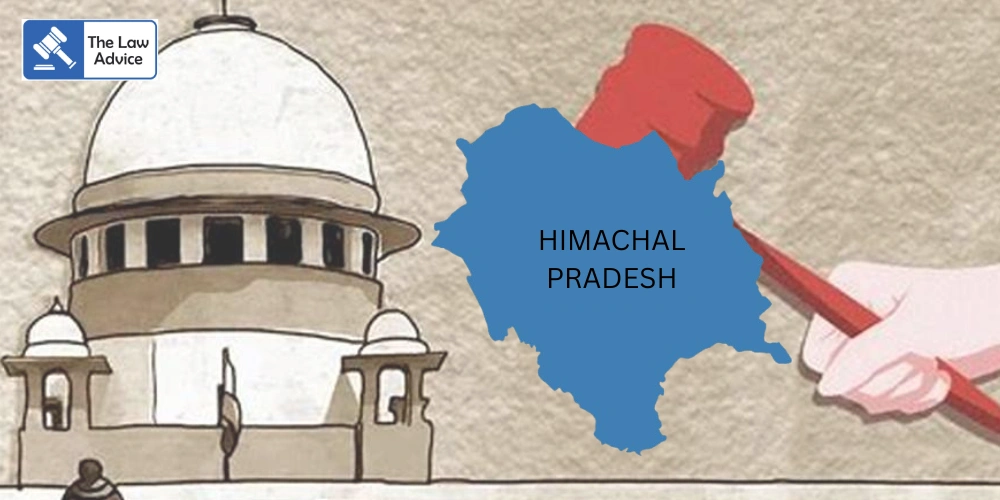The Supreme Court has pulled up the State of Himachal Pradesh over its handling of environmental degradation and unchecked developmental activities in the fragile Himalayan ecosystem. Observing that the State is facing nothing short of a “serious existential crisis”, the Court directed the Government to file a comprehensive, verified response addressing multiple ecological, developmental, and regulatory concerns.
The directions came in the suo motu matter In Re: Issues Relating To Ecology And Environmental Conditions Prevailing In The State of Himachal Pradesh | Writ Petition (Civil) No. 758 of 2025, taken up in the aftermath of the unprecedented monsoon rains earlier this year that triggered flash floods, landslides, and large-scale destruction of lives, livelihoods, and infrastructure across the State.
A Bench comprising Justices Vikram Nath and Sandeep Mehta, on September 23, 2025, noted that while the Himalayas are naturally vulnerable due to seismic activity and steep terrain, unregulated human interference has significantly worsened the risks. The Court had earlier observed that “humans, not nature” were responsible for recurring landslides, collapsing buildings, and sinking roads.
Hydropower projects, indiscriminate four-lane highway expansions, reckless deforestation, large-scale tree felling, and multi-storey constructions in ecologically sensitive zones were cited as major factors contributing to the recurring disasters.
The Bench also recalled a recent intervention by the Chief Justice of India-led bench which had expressed alarm over visuals of wooden logs being swept away in floodwaters—pointing to rampant, illegal tree-cutting operations in Himachal’s mountains.
Earlier, on August 25, 2025, the Court had appointed Senior Advocate K. Parameshwar as amicus curiae, assisted by Advocate Akashi Lodha, to assist in examining the State’s interim submissions. After reviewing the material, the amicus prepared a detailed questionnaire highlighting gaps in regulation, monitoring, and compliance.
The Supreme Court has now formally adopted this questionnaire in full and directed the State to provide precise, data-backed answers, duly affirmed by the Principal Secretary, Department of Forests, before the next hearing scheduled for October 28, 2025.
Key Areas of Information Sought
1. Zoning & Land Use
• Criteria used for zoning (considering seismic activity, landslide-prone areas, eco-sensitivity).
• Notification of eco-sensitive zones across protected areas.
2. Forests & Tree Cover
• Year-wise diversion of forest land for non-forest purposes over the last 20 years.
• Change in overall forest cover and species-wise tree data.
• Permissions granted for large-scale tree felling.
3. Compensatory Afforestation
• Number of trees planted in the past two decades.
• Survival rates of these plantations.
• Utilisation of funds earmarked for afforestation.
4. Climate Change & Glacial Retreat
• State’s existing climate change policy.
• Studies undertaken on glacier retreat.
• Projections on future impact in the Himalayan region.
5. Road Infrastructure & Landslides
• Number of four-lane highways constructed in Himachal.
• Data on landslides along these routes.
• Remedial and preventive measures undertaken.
6. Hydroelectric Projects
• Number of rivers on which projects have been undertaken.
• Cumulative environmental impact studies post-completion.
7. Mining & Heavy Machinery
• Current status of mining leases in the State.
• Protocols on use of explosives and heavy machinery in hilly terrains.
8. Tourism & Constructions
• Permissions granted for hotels, homestays, and rental accommodations.
• Restrictions on multi-storey constructions in eco-sensitive areas.
• Prosecutions, if any, under the Himachal Pradesh Town and Country Planning Act, 1977.
The Court’s intervention underscores the urgent need for Himachal Pradesh to strike a balance between development and environmental preservation. With increasing instances of natural calamities being worsened by man-made actions, the Bench stressed that sustainable planning, scientific zoning, and strict enforcement of environmental norms are non-negotiable for safeguarding the State’s fragile ecosystem.
The matter will next be taken up on October 28, 2025, when the Himachal Pradesh Government is expected to submit a comprehensive affidavit backed by empirical data and detailed explanations on the above issues.
